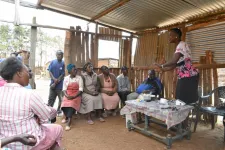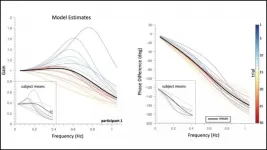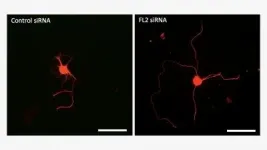(Press-News.org) While cardiovascular disease (CVD) remains the leading cause of death globally, new research led by NYU Grossman School of Medicine and Moi University School of Medicine (Kenya) found that addressing and incorporating social determinants of health (such as poverty and social isolation) in the clinical management of blood pressure in Kenya can improve outcomes for patients with diabetes or hypertension.
The study -- recently published online in The Journal of the American College of Cardiology - found that after one year, patients who received a multi-component intervention that combined community microfinance groups with group medical visits (where patients with similar medical conditions met together with a clinician and community health worker) had a 44 percent greater reduction in systolic blood pressure (SBP) compared to patients who received standard care for hypertension or diabetes.
The combined intervention proved especially beneficial for patients with uncontrolled hypertension at baseline. Group medical visits, according to the researchers, may also have benefits that extend beyond hard health outcomes, such as combating social isolation, increasing social cohesion, and improving clinician-patient trust.
"We know that health outcomes are largely determined by the conditions in which people are born, live and work, along with numerous other socioeconomic factors. The patient population in our study faced significant financial barriers to accessing care, ranging from inadequate health insurance, transportation costs, time lost from work, and myriad other challenges," says lead author Rajesh Vedanthan, MD, MPH, a cardiologist and director of the Section for Global Health in the Department of Population Health at NYU Grossman School of Medicine.
According to Vedanthan, the study's approach of combining microfinance and group medical visits can serve as a model for analogous programs in the United States that are attempting to integrate social determinants of health into care delivery. The challenges confronted by populations in Kenya--financial stress, unemployment, housing instability, and food insecurity--are experienced by numerous communities in the United States.
"While the exact form of implementation will need to adapt to local context, there are clearly people in the U.S. struggling with poverty, unemployment, racial discrimination and housing challenges who can benefit from a similar type of approach," says Vedanthan.
How the Study was Conducted
The study (known as BIGPIC: Bridging Income Generation with Group Integrated Care) protocol was developed by Dr. Vedanthan and colleagues from AMPATH Kenya, a partnership between Moi University, Moi Teaching and Referral Hospital and North American universities led by Indiana University.
The team of investigators enrolled 2,890 patients with diabetes or hypertension in western Kenya into four subgroups. The first group received usual AMPATH chronic disease care, which is multicomponent facility-based care consisting of individual visits with a clinician and medication management. The second group received usual care combined with microfinance initiatives, such as creating community savings groups to pool emergency savings and provide interest-bearing loans for group members in financial need. The third group received group medical visits, where participants met monthly with a community health worker, a clinician, and other patients with similar health challenges. The fourth received a combination of group medical visits and microfinance interventions. Researchers collected participants' data at baseline, three and 12 months.
Financial hardship was a common thread for the majority of participants. Nearly two-thirds were unemployed, more than 75 percent had an international wealth index of less than 40 (an indicator of poverty), and fewer than 17 percent were enrolled in the Kenya's national health national health insurance plan.
Study Findings
After 12 months, forty percent of study participants achieved blood pressure control. The greatest results were among patients in the microfinance and group medical visits arms of the study. The group that received combined microfinance and group medical visit interventions registered a 44 percent greater reduction in blood pressure compared to the group that received usual facility-based care. Overall, women (who made up 69.9 percent of study enrollees) experienced greater SBP reductions than men, as did younger individuals compared to older individuals. Those who actively participated in the integrated microfinance-group medical visit groups achieved greater SBP reduction.
The findings, Vedanthan hopes, will inform similar strategies to combat other chronic diseases worldwide, including in the U.S.
INFORMATION:
In addition to Vedanthan, additional co-authors are Jemima H. Kamamo, MMed, Diana Menya, MBChB, Violet Naanyu, PhD, Moi University in Eldoret, Kenya; Richard Mugo, ScM, Benjamin Andama, Cleophas W. Chesoli, MA, Simon Manyara, BPharm, and Vitalis Orango, BS AMPATH Kenya; Valentin Fuster, MD, and Carol R. Horowitz, MD, Icahn School of Medicine at Mount Sinai; Joseph W. Hogan, ScD, Stavroula A. Chrysanthopoulou, PhD, and Allison K. DeLong, MS, Brown University; Gerald S. Bloomfield, MD, David Edelman, MD and Eric A. Finkelstein, MD, Duke University; Sonak D. Pastakia, PhD, Purdue University; and Thomas W. Valente, PhD, University of Southern California, Los Angeles. Funding for the study was provided by the National Heart, Lung, and Blood Institute of the National Institutes of Health, grant number R01HL125487.
Media Inquiries:
Sasha Walek
646-501-3873
Sasha.Walek@nyulangone.org
A first-of-its-kind study led by The University of Texas at Austin has found that rock weathering and water storage appear to follow a similar pattern across undulating landscapes where hills rise and fall for miles.
The findings are important because they suggest that these patterns could improve predictions of wildfire and landslide risk and how droughts will affect the landscape, since weathering and water storage influence how water and nutrients flow throughout landscapes.
"There's a lot of momentum to do this work right now," said study co-author Daniella Rempe, an assistant professor at the UT Jackson School of Geosciences Department of Geological Sciences. "This kind of data, across large scales, is what is needed to inform next-generation models of land-surface processes."
The ...
The fact that the human body is made up of cells is a basic, well-understood concept. Yet amazingly, scientists are still trying to determine the various types of cells that make up our organs and contribute to our health.
A relatively recent technique called single-cell sequencing is enabling researchers to recognize and categorize cell types by characteristics such as which genes they express. But this type of research generates enormous amounts of data, with datasets of hundreds of thousands to millions of cells.
A new algorithm developed by Joshua Welch, Ph.D., of the Department of Computational Medicine and Bioinformatics, Ph.D. candidate Chao Gao and their team uses online learning, greatly speeding up this process and providing a way for researchers ...
A lot about the human brain and its intricacies continue to remain a mystery. With the advancement of neurobiology, the pathogenesis of several neurodegenerative diseases (ND) has been uncovered to a certain extent along with molecular targets around which current therapies revolve. However, while the current treatments offer temporary symptomatic relief and slow down the course of the disease, they do not completely cure the condition and are often accompanied by a myriad of side effects that can impair normal daily functions of the patient.
Light stimulation has been proposed as a promising therapeutic alternative for treating various ND like ...
The brain's auditory system tracks the speed and location of moving sounds in the same way the visual system tracks moving objects. The study recently published in eNeuro lays the groundwork for more detailed research on how humans hear in dynamic environments.
People who use hearing aids have trouble discriminating sounds in busy environments. Understanding if and how the auditory system tracks moving sounds is vital to improving hearing aid technology. Prior research utilizing eye movements to gauge whether the brain is following the trajectory of a moving sound indicates it cannot. A new study from García-Uceda Calvo et al. instead used head movements, a more accurate measure of sound tracking.
The team analyzed head movements of hearing ...
April 19, 2021--(BRONX, NY)--Researchers at Albert Einstein College of Medicine have developed a topical drug that regenerates and restores the function of erectile nerves damaged by radical prostatectomy, the most common treatment for localized prostate cancer. The drug was tested in rats, and the findings were published online today in JCI Insight.
"Erectile dysfunction (ED) after radical prostatectomy has a major impact on the lives of many patients and their partners," said study co-leader David J. Sharp, Ph.D., professor of physiology & biophysics and of ophthalmology and visual sciences and professor in the Dominick P. Purpura Department of Neuroscience at Einstein. "Since rats are reliable animal models in urologic research, our drug offers real hope of normal sexual ...
DALLAS - April 19, 2021 - Treating people with Type 2 diabetes with a new once-a-week injectable insulin therapy proved to be safe and as effective as daily insulin injections, according to the results of two international clinical trials published online today in Diabetes Care. The studies suggest that the once-weekly treatment could provide a convenient alternative to the burden of daily insulin shots for diabetes patients.
Starting and maintaining insulin treatment remain a challenge for millions of patients worldwide with Type 2 diabetes. Fear of injections and the inconvenience and burden of injectable therapy contribute to the barriers against insulin therapy initiation and adherence. The effectiveness and safety of ongoing insulin treatment are also highly dependent ...
Data from a GPS network in Colombia have revealed a shallow and fully locked part on the Caribbean subduction zone in the country that suggests a possible large earthquake and tsunami risk for the northwest region.
The locked patch south of Cartagena city is capable of generating a magnitude 8.0 earthquake every 600 years, said Sindy Lizarazo of Nagoya University in Japan, who presented the study at the Seismological Society of America (SSA)'s 2021 Annual Meeting.
Colombia lies in the middle of a complex tectonic zone, where the Caribbean, Nazca and South American tectonic plates and other smaller tectonic blocks converge. The Caribbean plate ...
Boston College seismologist John Ebel and his colleagues have noted a pattern for some large California earthquakes: magnitude 4 or larger earthquakes occur at a higher rate along a fault in the two decades or more prior to a magnitude 6.7 or larger earthquake on the fault.
The findings prompted Ebel in 2017 to suggest a prospective test. He looked for the California faults that had magnitude 4 or larger earthquakes occurring at a rate higher than 0.5 earthquakes per year from 1997 to 2016. If the pattern holds, the next magnitude 6.7 earthquakes in California are most likely to ...
Eighteen minutes might be all it takes to ensure a full recovery for stroke patients in rural South Carolina.
By changing EMS workflows and incorporating telemedicine techniques, physicians at MUSC Health have partnered with Georgetown Memorial Hospital and Hampton Regional Medical Center to significantly shorten the time between a patient's stroke symptom onset and their treatment, as recently reported in the Journal of Stroke and Cerebrovascular Diseases.
Through MUSC Health's Telestroke Network, emergency medical technicians (EMTs) can video chat with stroke specialists to begin a patient's consult before they even arrive at the hospital. ...
A new study finds a naturally occurring "earthquake gate" that decides which earthquakes are allowed to grow into magnitude 8 or greater.
Sometimes, the "gate" stops earthquakes in the magnitude 7 range, while ones that pass through the gate grow to magnitude 8 or greater, releasing over 32 times as much energy as a magnitude 7.
"An earthquake gate is like someone directing traffic at a one-lane construction zone. Sometimes you pull up and get a green 'go' sign, other times you have a red 'stop' sign until conditions change," said UC Riverside geologist Nicolas Barth.
Researchers learned about this gate while studying New Zealand's Alpine ...





